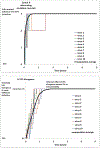Oral poliovirus vaccine evolution and insights relevant to modeling the risks of circulating vaccine-derived polioviruses (cVDPVs)
- PMID: 23470192
- PMCID: PMC7890645
- DOI: 10.1111/risa.12022
Oral poliovirus vaccine evolution and insights relevant to modeling the risks of circulating vaccine-derived polioviruses (cVDPVs)
Abstract
The live, attenuated oral poliovirus vaccine (OPV) provides a powerful tool for controlling and stopping the transmission of wild polioviruses (WPVs), although the risks of vaccine-associated paralytic polio (VAPP) and circulating vaccine-derived poliovirus (cVDPV) outbreaks exist as long as OPV remains in use. Understanding the dynamics of cVDPV emergence and outbreaks as a function of population immunity and other risk factors may help to improve risk management and the development of strategies to respond to possible outbreaks. We performed a comprehensive review of the literature related to the process of OPV evolution and information available from actual experiences with cVDPV outbreaks. Only a relatively small fraction of poliovirus infections cause symptoms, which makes direct observation of the trajectory of OPV evolution within a population impractical and leads to significant uncertainty. Despite a large global surveillance system, the existing genetic sequence data largely provide information about transmitted virulent polioviruses that caused acute flaccid paralysis, and essentially no data track the changes that occur in OPV sequences as the viruses transmit largely asymptomatically through real populations with suboptimal immunity. We updated estimates of cVDPV risks based on actual experiences and identified the many limitations in the existing data on poliovirus transmission and immunity and OPV virus evolution that complicate modeling. Modelers should explore the space of potential model formulations and inputs consistent with the available evidence and future studies should seek to improve our understanding of the OPV virus evolution process to provide better information for policymakers working to manage cVDPV risks.
© 2013 Society for Risk Analysis.
Figures



References
-
- Sutter RW, Kew OM, Cochi SL. Poliovirus vaccine-live In: Plotkin SA, Orenstein WA, Offit PA, editors. Vaccines. Fifth ed: Saunders Elsevier; 2008. p. 631–686.
-
- Salk JE. Requirements for persistent immunity to poliomyelitis. American Journal of Medical Science 1956;232(4):369–377 - PubMed
-
- Hammon WM, Ludwig EH. Possible protective effect of previous type 2 infection against paralytic poliomyelitis due to type 1 virus. American Journal of Hygiene 1957;66(3):274–280 - PubMed
-
- Chen RT, Hausinger S, Dajani AS, Hanfling M, Baughman AL, Pallansch MA, Patriarca PA. Seroprevalence of antibody against poliovirus in inner-city preschool children. Journal of the American Medical Association 1996;275(21): 1639–1645 - PubMed
Publication types
MeSH terms
Substances
Grants and funding
LinkOut - more resources
Full Text Sources
Other Literature Sources
Medical

